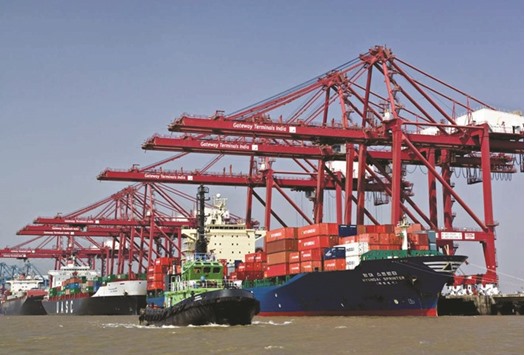India’s merchandise exports fell for the 13th successive month in December, as orders from the US and Europe shrank and exporters grappled with a competitively weaker Chinese yuan.
The deteriorating global economic growth outlook and rising volatility in currency markets have dampened Indian exports, although the blow has been softened by a collapse in the country’s oil import bill.
“We are facing terrible times as orders from the US and Europe have dried up,” said SC Ralhan, president of the Federation of Indian Export Organisations (FIEO), referring to shipments to India’s two largest markets.
“The slowdown in China and depreciation of its currency have further hit exports,” he said, adding that total merchandise exports could fall to about $250bn in the fiscal year ending on March 31. Exports in December fell 14.75% from a year earlier to $22.3bn while imports stood at 33.96bn, data from the Ministry of Commerce and Industry showed yesterday.
India’s merchandise exports declined 3.5% in 2014/15 to $310bn from the previous year while imports were down 0.5% to $448bn.
Cheaper Chinese exports have undercut exports of Indian engineering goods, which constitute around a quarter of total merchandise exports.
Engineering exports could fall to near $60bn in the current fiscal year from $72bn a year earlier, said TS Bhasin, chairman of the Engineering Export Promotion Council.
“My own exports are down by more than 30%, forcing me to retrench contract workers and sell in the local market at a lower price,” he said, adding more than 100,000 employees in engineering might lose their jobs.
Prime Minister Narendra Modi has made his Make in India programme, which seeks to attract foreign investment in export-oriented manufacturing, a centrepiece of an economic recovery plan that needs to create a million jobs a month to succeed. India’s trade deficit with China widened to $35.6bn during the April-November period from $32.4bn a year earlier. During that period, its exports to China fell to $6.2bn from $7.9bn a year ago, reflecting a severe imbalance in trade between the world’s two most populous countries. The government offered a fiscal package of about Rs27bn ($400mn) a year, in November to provide subsidised credit to exporters, hoping it could marginally help stabilise exports in coming months.
Finance Minister Arun Jaitley, who will present his annual budget for 2016/17 on February 29, is unlikely to provide much relief to exporters, officials said, as he faces a tough challenge to meet his fiscal deficit targets. “We do not have much hope though exporters’ survival is at stake,” Ralhan from the FIEO said.

The Jawaharlal Nehru Port in Navi Mumbai. India’s merchandise exports fell for the 13th successive month in December, as orders from the US and Europe shrank and exporters grappled with a competitively weaker Chinese yuan.
